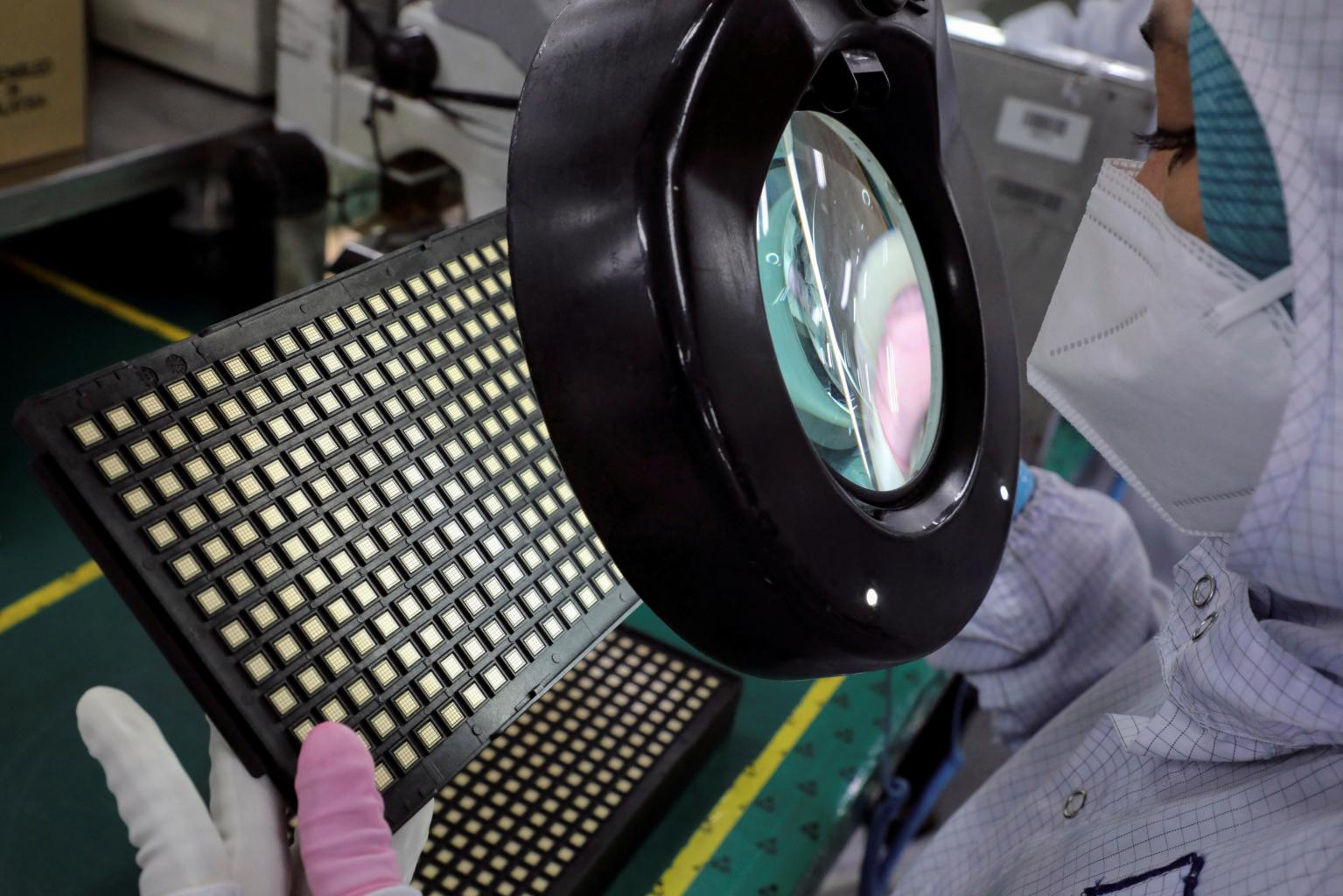India woos semiconductor manufacturers in bid for 'digital sovereignty'
Sign up now: Get insights on Asia's fast-moving developments

A policy announced last month seeks to develop a flourishing semiconductor and display ecosystem in the country.
PHOTO: REUTERS
Follow topic:
KOLKATA - India is rolling out the red carpet for semiconductor manufacturing companies in a bid to minimise its exposure to global supply chain risks associated with this critical commodity and also ensure its "digital sovereignty".
The Indian government began accepting proposals from international chip manufacturers from Jan 1 under a policy announced last month that seeks to develop a flourishing semiconductor and display ecosystem in the country.
The move is part of a wider ambitious policy to position India as a global hub for electronics system design and manufacturing with a total financial outlay of 2.3 trillion rupees (S$42 billion).
This includes a 760 billion rupees push for semiconductors and display manufacturing spanning different parts of the value chain, including design, testing, fabrication and packaging.
Key features include support of up to 50 per cent of the total project cost for applicants setting up semiconductor and display fabrication units as well as an incentive of up to half the cost of eligible expenditure for semiconductor design companies.
The government will also set up an "India Semiconductor Mission", helmed by global experts, to put in place long-term strategies for this sector.
India's latest moves have enthused the domestic semiconductor industry.
Mr Rajeev Khushu, chairman of the India Electronics and Semiconductor Association, told The Straits Times that the new policy has been "well thought out".
"This is unlike in the past when it was more about giving incentives on a take-it-or-leave-it basis. This one involves much more hand-holding of those willing to invest in the Indian semiconductor industry," he said.
"The ball is now in the manufacturers' courts."
Semiconductors have emerged as a strategic commodity given their indispensable role in everyday equipment and devices such as smartphones, cars and television sets.
India's effort to woo semiconductor majors comes amid an ongoing global shortage of vital computer chips that has affected critical industries and accentuated risks.
Three-fourths of the world's chip manufacturing is concentrated in East Asia, creating potential supply vulnerabilities due to unpredictable events such as natural disasters or infrastructure shutdowns.
"The economy that does not pay attention to semiconductors - their control, quality, design - and to talent development, that country cannot progress," Information and Technology Minister Ashwini Vaishnaw told reporters last month, while sharing details of this policy.
Following the latest moves, the minister told Bloomberg Television that India expects at least a dozen semiconductor manufacturers to start setting up local factories in the next two to three years.
The new policy has caught the attention of manufacturers.
Intel Foundry Services President Randhir Thakur praised the incentives in a tweet on Dec 27, which was later retweeted by Mr Vaishnaw, with a cryptic "Intel - welcome to India" remark.
The company has not announced any specific manufacturing plans for India since.
The Indian semiconductor market was valued at US$15 billion (S$20.3 billion) in 2020 and is estimated to reach US$63 billion by 2026.
Much of the growth until 2030 will be driven by wireless communications, consumer electronics and automotive electronics.
While home to many semiconductor research and development units owned by top global firms, the country still lacks a large-scale commercial semiconductor manufacturing facility.
Mr Khushu said this is because setting up a fabrication unit is very capital-intensive with a "decent-sized" unit costing anywhere between US$5-10 billion.
India's weak infrastructure has also acted as a barrier. He, however, added that development over the years has "changed the game".
"Whether it is power infrastructure, road infrastructure or the airports coming up, I think we are much better off now to handle a large-scale fab compared to probably 10 or 12 years back."
India has made significant strides in electronics manufacturing with the industry's current worth valued at US$75 billion, a figure the government expects will climb to US$300 billion in the next six years.
The country is also home to a Samsung mobile manufacturing unit in Noida that the company has billed as the world's largest.
India is in a much better position now to attract semiconductor manufacturers than five years ago, Ms Priya Joseph, a research analyst at global industry analysis firm Counterpoint, told ST.
But the country still has a lot to do to compete with manufacturing hubs such as China and Vietnam, she added.
"The infrastructure needs are there but there is still a need for a lot of integration and clarity in terms of regulatory procedures, both at the centre and state level," she said, in a reference to India's complex and cumbersome land acquisition laws.
Ms Joseph added that India should not get too caught up in the pursuit for semiconductor self-reliance and instead exploit its comparative advantages.
"India's foreign policy here will be tricky because that is the way you develop technology and share knowledge… I don't think any one country can become self-sufficient for something as critical as semiconductors. It is very unrealistic."

